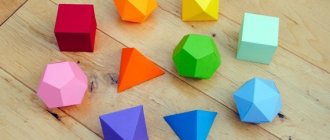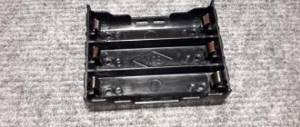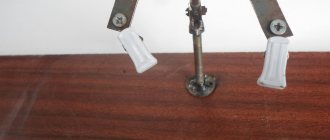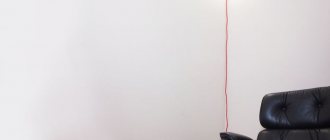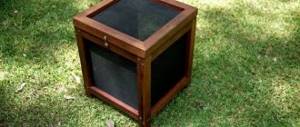Holographic pyramid - what is it? Myth or miracle of modern scientific thought? What is it? A very beautiful image appearing out of nowhere in the air. With it you can create real holograms, just like in the movies!
The holographic pyramid is a spectacular animation. Technology of the future. They have been renting for a long time. And here you can read how to make them yourself.
The holographic pyramid can be used for your presentation or to advertise your store. It is equipped with speakers, which can be very appealing to your customers. In shopping centers, it significantly helps promote sales. If you need to run a promotion, holographic pyramids are a great solution. They can also be used as part of a promotional stand. Shops, bars, cafes and restaurants have been using holographic pyramids for a long time. Also, for example, car manufacturers or car dealership owners can show new cars to visitors from all angles.
The holographic pyramid is very easy to use. You just need to turn it on. If you want to attract attention or surprise your guests, then this article will help you understand all the intricacies of making a holographic 3D pyramid.
Principles of Physics
Amplitude and phase characterize wave objects. You can register the amplitude without any problems. A real holographic pyramid can be recorded without any problems by ordinary photographic film. She transforms it into photographic blackening. Interference is needed to register the phase relationships of the holographic pyramid. It converts it into phase amplitude relationships. Interference is created using several electromagnetic waves.
The frequencies of these waves of the holographic pyramid must match. Two waves must be added in a specific area to record a hologram. One of these areas is the reference wave. The other is the object wave of the holographic pyramid. At this point you need to insert a record or any other material. As a result, a picture appears in this area. To obtain an object wave, you need to illuminate this plate with a reference wave. As a result, we will receive the same light that is reflected from the recording object.
Scientists were able to create three-dimensional holograms using a laser
In many films we come across various holograms: for example, many remember the hologram of Leia from the 4th episode of Star Wars.
However, in reality, until recently, this was a fantasy: scientists have developed many concepts, from laser illumination of steam to rapid frame changes on rotating transparent glass, but, alas, all these methods did not provide a clear and bright three-dimensional image. For the first time, holograms, which are three-dimensional images of objects, were able to be obtained in 1947 by the Hungarian physicist Denes Gabor. His idea was simple: in a certain region of space, two waves with very close frequencies are added (interfered): one of them comes from the source, the other directly from the recording object. And if a photographic plate is placed in this area, a complex pattern of darkening bands will appear on it (which is called an interference pattern). And if we now illuminate this plate with a wave coming from the source, then we will see, with varying accuracy, the reflected light, which is similar to that which would be reflected from the recording object - that is, we will see a hologram. However, such a hologram would not be like what we see in science fiction - it would be visible at a limited range of angles, it would not be able to be rotated and viewed from all sides.
Recently, several methods for manufacturing volumetric displays (devices that make it possible to obtain real 3D holograms) have appeared, where these problems have been partially solved. In them, light is scattered not on a photographic plate, but directly on the points that form the image - that is, on particles of matter floating in the air. A total of three displays of this kind have been developed, but they all have their drawbacks: induced plasma displays cannot produce a color image, and modified aerial displays and displays with acoustic levitation cannot provide image accuracy similar to a conventional hologram.
However, a team of scientists led by Daniel Smalley from Brigham Young University managed to solve these problems and create a color volumetric display capable of creating images with a resolution of tens of micrometers. With this new technology, "you can actually achieve what everyone is hoping to achieve, which is to create an image of Princess Leia from a scene in Star Wars," says Curtis Broadbent, a physicist at the University of Rochester in New York.
The principle of operation of the new display is quite simple: scientists took an opaque cellulose particle with a diameter of several micrometers and enclosed it in an optical trap - a region of space where the movement of the particle can be controlled using a laser. In this experiment, a laser with a wavelength of 405 nm (violet color) was used, which made it possible to move it at a speed of up to 18 m/s and an acceleration of up to 58 m/s2 - this was quite enough for the observer, due to the inertia of vision, to see more than one moving point, but a solid object (a complete analogy with freezelighting, only here the speed of moving the point is significantly higher, which allows you to see the whole picture without using shutter speed). At each point along the path, the particle is illuminated by three lasers - red, green and blue, which allows it to be painted in any desired color. The final mechanism looks like this:
Using this installation, it was possible to play three-dimensional video at a frequency of about 13,000 frames per second, and each frame consisted of 16,000 color dots, which made the flickering of the image completely invisible to the eye. By increasing the shutter speed to a minute, scientists were able to create complex images - the size of the holograms was comparable to a postage stamp, and the number of colors was 16 million (24-bit color):
However, scientists do not intend to stop there: “Increasing the hologram, even to the size of a monitor, would be quite difficult,” says Broadbent. The researchers would have to improve their prototype to take pictures using large numbers of particles. Smalley says he already envisions a system that manipulates hundreds or even thousands of particles at once. With these improvements, “the sky is the limit,” he says.
Free-floating images have a bright future: surgeons can practice operations on them before performing them on live patients. The same technology can be used to improve athletic performance: People can record themselves performing various exercises and then view them on 3D screens. With the help of such holograms, it will be easier for dispatchers to monitor aircraft in the air, and for scientists to monitor satellites in space.
According to Broadbent, the possibilities for such systems for advertising, educational and entertainment purposes are endless. The world in the future could become filled with floating holograms, similar to those featured in the movie Jurassic World, where museum visitors visit a hallway with a hologram of a dinosaur. People in the future will be able to easily try on clothes, just like Tony Stark in the movie Iron Man tries on a hologram of a suit. And, unlike virtual reality systems, these new laser holograms can be observed with the naked eye: no helmets or glasses are required, you will see everything with your own eyes.
How to make a holographic pyramid?
If you want to draw a pyramid sketch yourself or print a stencil, you will need:
- A sheet of paper, a ruler and a pencil.
- Scissors.
- Stationery knife.
- Transparent tape.
- Clear plastic or DVD boxes.
To reproduce the hologram, you will need:
- Smartphone.
- Video.
- Ready pyramid.
It's very easy to make a 3D pyramid. Its principle is this:
- You need to draw a stencil of the edge of a 3D pyramid.
- From the cut out stencil you need to make four plastic blanks.
- Glue the pieces together, for example, with tape or glue.
- Done. Now you need to watch a special video, first by placing the pyramid on the screen.
If there is no glass, you need to take plastic from the box.
Welcome to the world of the latest advertising technologies!
The laboratory of non-format advertising “Hephaestus Projection” presents to your attention a new generation advertising medium “Holographic Pyramid”.
“Holographic 3D Pyramid” is a unique tool that will allow you to demonstrate a three-dimensional model of your product without the use of special 3D glasses. The “3D pyramid” will make the space of any exhibition stand more attractive, will become its “highlight”, will look great as an advertising and presentation structure in a shopping and entertainment center, and will also fit perfectly into the interior of a business center or museum. The use of a “projection pyramid” allows you not only to carry out a bright advertising campaign, but also to arouse genuine interest on the part of potential clients, which undoubtedly leads to increased brand awareness and creates a positive image of yours. Almost any product can be presented in a completely new way. Whatever you advertise: mobile phones, tablet computers or cameras, various accessories, watches or jewelry, children's products or food products, with the help of a “3D pyramid” and a colorful holographic projection you will add a little magic to the presentation of your product, brand or companies. Once you look at this achievement of engineering, you will forever change your attitude towards visual presentations, and towards advertising in general.
It is worth noting that it is not a distributor for the sale of “3D pyramids”. We produce them ourselves in our production facilities. When creating “Holographic Pyramids” we use the most advanced achievements and developments in the field of projection technologies. A holographic projection in a “3D pyramid” is created using a multimedia player or computer, a high-contrast Full HD matrix and a glass system with a special chemical coating that transmits the main light flux, while retaining a certain part of it and thereby creating a three-dimensional image that seems floating in the air. Essentially, the “holographic 3D pyramid” is a projection surface onto which pre-created video content is broadcast. The Holographic Pyramid installation can be integrated with real world objects. You just need to place an object in the pyramid and create a video that merges with the object. Highly professional specialists are able to create any video material according to the customer’s technical specifications. We can satisfy almost all your needs, and we also guarantee the quality of our products and provide technical support.
Pyramid dimensions
The holographic pyramid has the following dimensions: the width of the upper part of the stencil is 10 mm, the lower part is 60 mm, and the height is 35 mm. It is also very important that the pyramid should be at an angle of 45 degrees. Next, attach the stencil to the glass. It needs to be temporarily glued with double-sided tape. Next, we’ll make cuts using a knife and break off the glass using pliers. First, you can clamp the workpiece in a vice.
As a result, the workpiece should look like a triangle. We process chips with sandpaper. We perform the same actions 3 more times. As a result, we should have four pieces of workpiece.
When all the blanks are ready, you need to remove the backings and glue them together with a glue gun. Our task is completed, so that we can see the illusion, we need to install it in the center on the smartphone screen. You also need to cover the pyramid with a piece of cardboard. We launch the picture and observe from any angle.
Production technology of “Holographic 3D pyramid” complexes
Installations such as “Holographic Pyramid (Scandinavia 360)”, “Holographic Cube (Holocube POP)” are created at our own production base in the Moscow region and the city of Novosibirsk.
The body material depends on the configuration of the 3D pyramid, its dimensions and the customer’s wishes.
Types of body material:
- Aluminum (alucobond) (black/white)
- Kiln painted 3 layers of MDF
- MDF with decorative films applied
- Plastic/acrylic
- Artificial stone CORIAN
Dimensions of video images in a holographic pyramid
| 3D pyramid model | Number of sides for hologram visualization | Video size per side, width*height |
| 3D pyramid 42 | 3 | 12 * 12 |
| 3D pyramid 64 | 3 | 15 * 15 |
| 3D pyramid 90 | 3 | 19 * 19 |
| 3D pyramid 110 | 3 | 22 * 22 |
| 3D pyramid 145 | 3 | 27 *27 |
| HOLOCUBE | 1 | Video size = diagonals of the matrix underlying the installation |
Holographic glass : The main element that allows you to reproduce 3D content in a holographic pyramid and achieve the effect of presence, the holographic effect, is glass elements. The glass in 3D pyramids is not ordinary - professional multifunctional glass is applied in production with an additional 4 layers, including with a special coating, which allows minimizing all the shortcomings of standard glass, increasing contrast and minimizing glare from stray external illumination.
Our engineers will calculate for you an individual holographic pyramid made of material according to your technical specifications, of any size and with any number of active sides.
It is possible to embed a holographic pyramid into the facades of structures or into exhibition stands.
